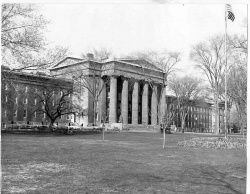Utica State Hospital
| Utica State Hospital | |
|---|---|
 | |
| Construction Began | 1842 |
| Opened | 1843 |
| Current Status | Active and Preserved |
| Building Style | Cottage Plan |
| Architect(s) | William Clarke |
| Location | Utica, NY |
| Architecture Style | Greek Revival |
| Alternate Names |
|
History
The Utica Psychiatric Center, also known as Utica State Hospital, which opened in Utica in 1843, was New York's first state-run facility designed to care for the mentally ill and was one of the first such institutions in the United States, predating and perhaps influencing the Kirkbride Plan which called for similar institutions nation-wide. It was originally called the New York State Lunatic Asylum at Utica. The Greek Revival structure was designed by Captain William Clarke and was funded through a combination of money provided by the state and contributions raised by Utica residents.
The asylum's first director was Dr. Amariah Brigham, who in 1844 became one of the original founders of American Psychiatric Association. An early proponent of treating mental illness rather than simply confining its sufferers, Dr. Brigham believed that his patients would benefit from the opportunity to work on the asylum's farm and grounds and on other useful occupational projects. Dr. Brigham established a print shop at the asylum, where he published the American Journal of Insanity (later known as the American Psychiatric Journal).
The asylum was also the site of the invention of "The Utica Crib". The Utica Crib was named after the New York State Lunatic Asylum at Utica where it was heavily used in the 19th century to confine patients. The crib was based on a French design, then modified to incorporated slats that gave it an appearance similar to a child's crib. While use of the Utica Crib was widely criticized and infamous among patients, some found it to have important therapeutic value. A patient who slept in the Utica crib for several days commented that he had rested better and found it useful for "all crazy fellows as I, whose spirit is willing, but whose flesh is weak." (Journal of Insanity, October 1864.) In an opposing view, Daniel Tuke, a noted British alienist (an early term for a psychology expert) writes that, "it inevitably suggests, when occupied, that you are looking at an animal in a cage. At the celebrated Utica Asylum... where a suicidal woman was preserved from harm by this wooden enclosure... Dr. Baker of the New York Retreat allowed himself to be shut up in one of these beds, but preferred not remaining there."[1]
The building has been a National Historic Landmark since 1989.
Images of Utica State Hospital
Main Image Gallery: Utica State Hospital
References
Carla Yanni, The Architecture of Madness, University of Minnesota Press, page 42-45. Yanni argues that the Utica plan is not relevant to later Kirkbride plans.

